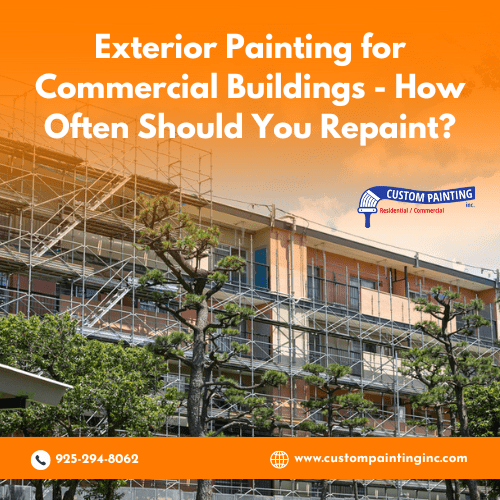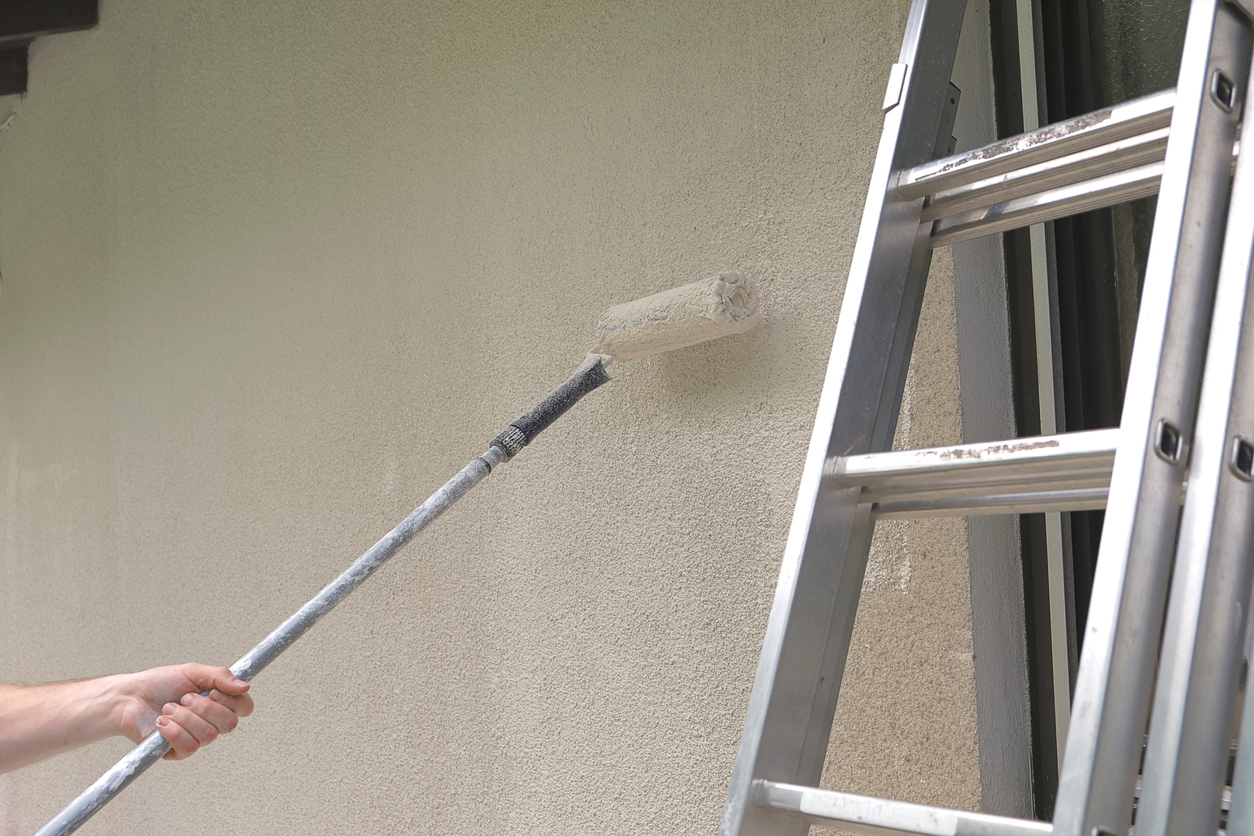It is crucial to maintain the exterior of a commercial building, not just for aesthetics but also to protect the investment. Regular repainting can prevent damage, boost curb appeal, and reflect your business’s professionalism. This guide will help you understand how often you should repaint.
How Often Should Commercial Buildings Be Repainted?
The general recommendation for repainting commercial buildings ranges from 5 to 10 years, but this can vary based on several factors discussed below.
Here’s a more specific breakdown by common materials:
- Wood Siding: Wood is more susceptible to weather damage than many other materials. It tends to absorb moisture, leading to rot or warping, and sun exposure can cause paint to fade or peel quickly. On average, wood siding should be repainted every 3-7 years.
- Stucco: Stucco is quite durable and resistant to weather conditions but can still crack and chip over time. Typically, stucco should be repainted every 5-10 years, depending on the climate and the quality of the previous paint job.
- Aluminum Siding: Aluminum siding holds paint well and is resistant to rust. However, it can fade and chalk over time due to exposure to the elements. Repainting is generally recommended every 5-10 years.
- Vinyl Siding: Vinyl siding is very low maintenance and doesn’t require painting for protective reasons. However, if a color change is desired or if the original color has faded, painting every 10-15 years can refresh its appearance.
- Brick: Brick generally requires less frequent painting. If previously painted, it may need a new coat every 15-20 years. Unpainted brick might only need occasional cleaning unless you decide to paint it for aesthetic reasons.
- Concrete Block: Concrete block is very sturdy and typically only needs repainting every 10-15 years, depending on environmental exposure. If the blocks are sealed and painted well, they can resist weathering effectively.
- Fiber Cement Siding: This durable material can go longer between paint jobs. Typically, fiber cement siding should be repainted every 10-15 years.
- Metal Siding: Depending on the type of metal and whether it’s coated, metal siding can usually last a long time without needing a repaint. Generally, repainting every 10-20 years is adequate unless corrosion or cosmetic issues arise earlier.
Factors That Determine Repainting Frequency
1. Climate Conditions
The local weather is perhaps the most significant factor in how often you’ll need to repaint. Buildings in areas with harsh climates—be it heavy rain, strong sunlight, snow, or high humidity—often require more frequent repaints. For instance, intense sun can fade and deteriorate paint faster, while cold, wet climates can lead to moisture damage and mold.
2. Building Material
Different materials react differently to environmental stresses and paint adherence. For example:
- Wood absorbs moisture and can expand and contract with temperature changes, necessitating more frequent repaints.
- Metal might rust or corrode if not properly maintained, especially in salty coastal areas.
- Concrete and stucco can last longer between repaints but may show signs of wear, such as cracking that needs addressing.
3. Quality of Previous Paint Job
A high-quality paint job using top-grade paint and proper techniques can significantly extend your paint’s life. Factors like the number of coats applied, the type of paint used, and proper surface preparation all play a crucial role. Cheaper paints or inadequate preparation can lead to a shorter lifespan for your paint job.
4. Exposure to Pollutants
Urban environments or areas close to industrial activities can expose your building to pollutants and chemicals that may accelerate paint deterioration. Regular exposure to such contaminants can degrade paint faster, requiring more frequent touch-ups.
5. Color and Type of Paint Used
Darker colors tend to absorb more heat, which can lead to faster degradation and fading. On the other hand, lighter colors might last longer but could show dirt and stains more readily. The type of paint (e.g., oil-based vs. latex) also affects durability. Latex paints, for example, are generally more flexible and fade-resistant than oil-based paints.
6. Building Usage
The function of your building can also impact how often it needs repainting. Buildings with high foot traffic or mechanical wear might see paint wear down faster due to physical contact or abrasion.
7. Aesthetic Standards
Some businesses may choose to repaint more frequently simply to refresh their look or change branding. Maintaining a specific aesthetic standard can be crucial for customer perception and business branding.
Signs That Your Building Needs Repainting
1. Fading Color
Over time, paint exposed to the sun will lose its vibrancy. This is more than just an aesthetic issue. Faded paint can be a sign of weakening protection from the elements. If your building’s once bright and bold colors look washed out, it might be time to freshen up with a new coat of paint.
2. Peeling or Cracking Paint
This is one of the most obvious signs that repainting is needed. Paint that is peeling or cracking has lost its ability to protect the building’s exterior, leaving it vulnerable to moisture and other damaging elements. This deterioration can lead to more severe issues like wood rot or further degradation of the underlying materials.
3. Mold, Mildew, or Algae Growth
The presence of mold, mildew, or algae on painted surfaces indicates that moisture accumulates, which can deteriorate the paint and the materials beneath. These growths not only look unsightly but can also pose health risks and should be addressed promptly. Repainting with moisture-resistant paint and ensuring proper sealing can help prevent future growth.
4. Bubbling Paint
Bubbling or blistering paint usually means that water has seeped underneath the paint layer, possibly due to leaks or high humidity. This trapped moisture can damage both the paint and the surface it covers. If bubbling is widespread, it’s a clear sign that a thorough inspection and likely a repaint are necessary.
5. Caulking Failure
Caulking around windows, doors, and joints is crucial in sealing out water and air. If you notice that the caulking is dried out, cracked, or missing, it could lead to water intrusion and damage. While you might just need new caulking, it’s often an opportunity to consider a full repaint if other signs of wear are present.
6. Hardened or Brittle Paint
Over time, paint can become hard and brittle, losing its elasticity. This makes it more likely to crack or chip away under minor pressures, such as small impacts or temperature changes. If the paint no longer seems to have a slight give when pressed, it might be aging out of its protective role.
7. Chalking
If you run your hand across the paint and a powdery residue comes off, this is called chalking. It’s a sign that the paint is breaking down and can no longer offer adequate protection from the sun and weather.
Pro Tips for Assessment:
- Visual Inspection: Regularly walk around your property to inspect the condition of the paint. Look for the signs mentioned above and any other irregularities.
- Professional Evaluation: If you’re unsure about the condition of your building’s paint or if it’s been a long time since the last paint job, consider hiring a professional. They can provide a detailed assessment and recommend the best course of action.
- Stay Proactive: Addressing these issues early can prevent more significant problems, saving time and money.
Stay alert to these signs to keep your commercial building looking great and well-protected against the elements. Remember, a well-maintained exterior is crucial not only for curb appeal but also for the longevity of your property.
Reasons to Repaint Your Commercial Building
1. Protection Against the Elements
One of the primary reasons to repaint is to protect the building’s structure. Paint acts as a barrier against water, sun damage, and pollutants that can cause materials to degrade over time. Regular repainting helps prevent rot, mold growth, and rust, especially in harsh climates.
2. Boost Curb Appeal
First impressions matter, and the exterior of your building is often the first thing a customer or client sees. A fresh coat of paint can transform a drab, worn-out-looking building into a vibrant, inviting place. This makes your property more attractive and can significantly influence customer perception and behavior.
3. Increase Property Value
A well-maintained building tends to have a higher market value. Repainting your building can be a cost-effective way to enhance its appeal if you’re considering selling or leasing space. New paint makes the property look newer, cleaner, and more cared for, appealing to potential buyers or tenants.
4. Update Your Branding
As businesses evolve, their branding needs might change. Repainting allows you to align your physical premises with your current branding and aesthetic. Whether it’s a logo color scheme or simply a modernization of your look, updating your exterior paint can reflect positively on your brand’s identity.
5. Improve Cleanliness
Over time, building exteriors can accumulate dirt, dust, and grime. This build-up can make even well-designed buildings look neglected. A new paint job will not only clean up these appearances but also allow you to apply newer paints that are easier to clean and maintain against dirt and fungal growth.
6. Regulatory Compliance
In some areas, there might be regulatory reasons to keep your building well-maintained, including the paint condition. This could be particularly relevant in historic districts or areas with specific business operation standards set by local authorities.
7. Employee and Tenant Satisfaction
A nicely maintained workplace can boost employee morale and tenant satisfaction. It shows that you care about the environment they work in, which can enhance productivity and happiness. For properties with multiple tenants, this can also be a selling point to attract higher-quality leases.
Conclusion
Repainting your commercial building is vital to maintaining its structural integrity, aesthetic appeal, and market value. Recognizing the signs that it’s time for a repaint, understanding the factors that affect paint longevity, and getting a commercial painting service from Custom Painting Inc. will ensure that your property remains in top condition. Contact us through our website by filling out the form to request an appointment and receive a free estimate, or you may call us at 925-294-8062.



